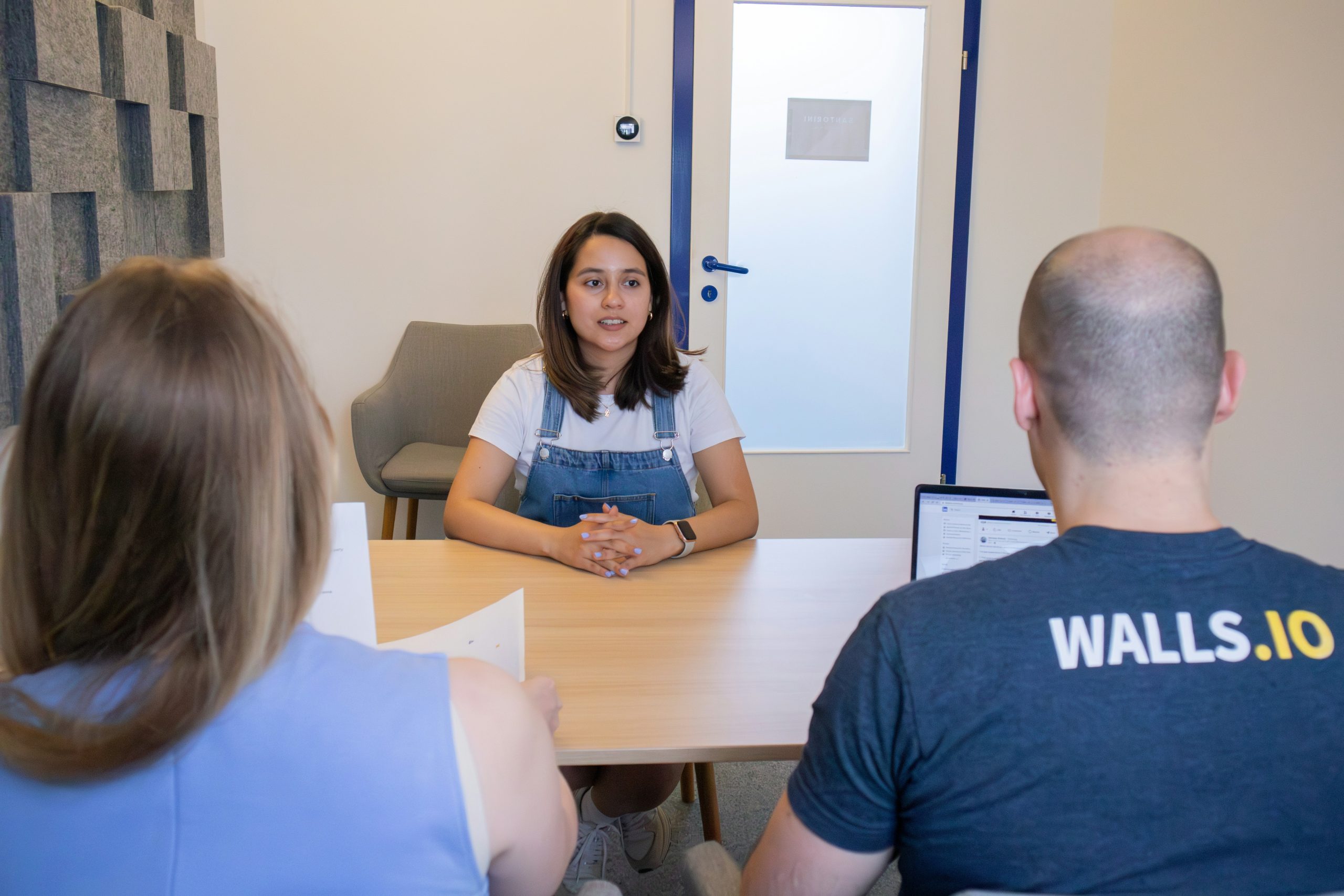
Subscribe for updates
Get talent acquisition best practices, trends, and news delivered directly to your inbox.
By entering your email, you agree to receive marketing emails from JobScore
The interview invitation email is often a candidate’s first direct interaction with your company’s hiring team. It does more than just schedule a meeting — it can be the difference between a candidate accepting or declining your interview request, reflects your company culture, and sets the tone for your entire hiring process.
An efficient, professional, and welcoming interview invitation process can help your company stand out so you can improve hiring outcomes.
What to include in an interview invitation email
Crafting an effective interview invitation email requires detailed and thoughtful communication that makes it easy for candidates to respond.
Clear subject line
A clear subject line is crucial to get your candidate’s attention and immediately communicate the purpose of your email.
Something as simple as “Interview Invitation — [Position] at [Company Name]” works well. This direct approach helps ensure your email won’t get lost in the candidate’s inbox and communicates its importance immediately.
Personalized greeting
Your email greeting should be personalized with the candidate’s name. While this might seem obvious, many automated systems still send generic “Dear Candidate” emails, which can feel impersonal and decrease engagement rates. A simple “Hi [First Name]” sets a professional yet approachable tone.
Brief introduction
Begin your email by explaining why you’re reaching out.
For example, “Thank you for applying for our [position title] role at [company]. We’re impressed by your experience in [skill/industry, etc] and would like to learn more about you.”
Interview logistics
Share some interview logistics so you candidates know what to expect. It’s important to be crystal clear to avoid any confusion or back-and-forth communication.
You might include the following details:
Next steps and expectations
Clearly outline what the candidate needs to do next. While it’s common to offer candidates a few timeslots to choose from, interview self-scheduling can help you provide a better candidate experience.
It’s also a good idea to let candidates know if you can make yourself available outside of listed times to accommodate their schedule. For example, some candidates may not be available to interview during normal work hours.
Soft sell
Consider including supplementary information that can help candidates make the decision to schedule an interview.
You might include the following details:
Closer
Close your interview invitation email by expressing how excited you are to move forward with the candidate, and making yourself available to answer any questions or address any concerns.
Interview invitation email templates
Below are several customizable email templates designed for different scenarios. Remember to modify these templates to match your company’s voice and specific needs.
Phone interview invitation template
Subject: Interview Invitation for [Position Name] at [Company Name]
Hi [Candidate Name],
Thanks for applying for the [Position Name] role at [Company Name]. I’m impressed with your background in [skill/industry] and would love to learn more about you.
The first step of our hiring process is a quick phone call with me. If we determine mutual fit, this will be followed by a video call with our hiring manager next week, and an onsite interview the week after that.
Please use the link below to schedule a 15 minute phone interview at a time that’s convenient for you.
Feel free to reach out if you have any questions.
I look forward to chatting with you!
Best regards,
[Full Name]
[Job Title]
[Contact Information]
Please click here to schedule your interview
Video interview invitation template
Subject: Interview Invitation for [Position Name] at [Company Name]
Hi [Candidate Name],
Thank you again for taking the time to chat with me last week! I enjoyed getting to know you and am excited to invite you to the next stage of our interview process: A 30 minute video interview with the hiring manager, [Name].
Available time slots include:
- [Date, Time]
- [Date, Time]
- [Date, Time]
What to expect:
- The interview will focus on your experience with [Specific areas]
- We’ll discuss [Specific topics]
- There will be time for you to ask questions about the role and company
Please reply with your preferred time slot, and we’ll send detailed instructions for video call. If none of these dates and times work for you, please let me know your availability for the next few days so I can try to accommodate your schedule.
I look forward to speaking with you!
Best regards,
[Full Name]
[Job Title]
[Contact Information]
Onsite interview invitation template
Subject: Interview Invitation for [Position Name] at [Company Name]
Hi [Candidate Name],
Thank you again for taking the time to chat with [Hiring manager] last week! We’re excited to extend an invitation for an onsite interview.
The interview will include:
- An in-depth discussion about your experience and the role with the hiring manager, [name] (30 minutes)
- A skill assessment (30 minutes)
- A meet-and-greet with a few additional team members over lunch or coffee/tea (1 hour)
The interview will take place at: [address].
Please use the link below to schedule the interview at a time that’s convenient for you. We can be flexible if the available times won’t work with your schedule—just let me know!
Our team is looking forward to meeting you!
Best regards,
[Full Name]
[Job Title]
[Contact Information]
Please click here to schedule your interview
Tips for maximizing response rates
The success of your interview invitation emails can be measured by candidate response rates and acceptance of interview slots. Here are some strategies to improve these metrics:
Reduce time between touchpoints
Make quick decisions at every stage in the recruitment process so you can follow-up with candidates in a timely manner. This mitigates the risk of candidates accepting another offer before you even have a chance to interview them.
Send emails during business hours
Send interview invitations during business hours in the candidate’s timezone, preferably between Tuesday and Thursday. Mid-week emails usually mean candidates aren’t still catching up from the weekend nor planning for it.
Provide multiple options
Offer at least three different interview time slots spread across different days and times. This demonstrates flexibility and increases the likelihood of finding a mutually convenient time. However, don’t overwhelm candidates with too many options, which can lead to decision paralysis.
Follow up strategically
If you don’t receive a response within 48 hours, send a polite follow-up email. Keep it brief and professional:
Subject: Following up: Interview Invitation for [Position]
Hi [Candidate Name],
I’m following up on the interview invitation I sent on [date] for the [Position] role. We’re still very interested in speaking with you and would love to schedule a conversation.
Are any of the previously suggested times convenient for you? If not, please let me know your availability, and we’ll work to find a suitable time.
Best regards,
[Your name]
Use automation wisely
While automation can streamline the scheduling process, ensure your emails maintain a personal touch. Use an applicant tracking system that allows for personalization tokens and template customization.
Final thoughts on interview invitation emails
Well-crafted interview invitation emails are a crucial component of an efficient and successful hiring process. They serve as your company’s first impression on potential employees and set the tone for the entire recruitment experience. By following the guidelines and templates provided in this guide, you can create professional, welcoming, and effective interview invitations that save time, reduce costs, and improve your candidate experience.
Remember that these templates are starting points — customize them to reflect your company’s culture and values while maintaining professionalism and clarity. Regular review and optimization of your interview invitation process, based on response rates and candidate feedback, will help you continue to improve your recruitment outcomes.
The time invested in creating and maintaining good interview invitation templates pays dividends in terms of reduced administrative work, improved candidate experience, and ultimately, better hiring decisions. Every touchpoint with potential employees matters, and your interview invitation email is often the first step in building a strong relationship with your future team members.
JobScore can help you send customized interview invitation emails that improve candidate communications and boost your candidate experience. Start a free trial to see it in action.



